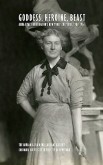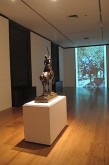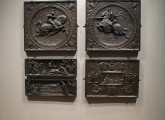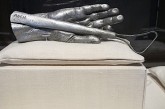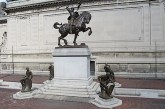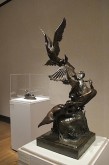The browser will either open the file, download it, or display a dialog.
Goddess, Heroine, Beast: Anna Hyatt Huntington’s New York Sculpture, 1902–1936
The Miriam & Ira D. Wallach Art Gallery, Columbia University in the City of New York
New York, New York
January 22–March 15, 2014
Catalogue:
Goddess, Heroine, Beast: Anna Hyatt Huntington’s New York Sculpture, 1902–1936.
Anne Higonnet, ed.
New York: The Miriam & Ira D. Wallach Art Gallery, Columbia University in the City of New York, 2014.
48 pp.; 18 color illus.; 66 b&w illus.; time line; map of major works by the artist in Manhattan.
$10 (softcover)
ISBN: 978-1-884919-31-2
Driving from New Jersey to Manhattan sometime last spring, the radio tuned to National Public Radio, we happened on an interview with Alan Rabinowitz. For readers who do not know of him (as I did not), Rabinowitz is the founder of the world’s first jaguar preserve (Belize, 1986) and the CEO of Panthera, a non-profit organization devoted to the preservation of big cats across the world. Rabinowitz told his inspirational story of growing up as a terrible stutterer, incapable of communicating. One day his parents noticed that, left alone with his stuffed animals, he talked without effort. That prompted them to take young Alan to the Bronx Zoo, hoping that the sight of animals would similarly get him to speak normally. In the interview, Rabinowitz related that, already as a child, he felt a special connection and empathy with animals. Looking into the sad eyes of the caged beasts in the Bronx Zoo’s Big Cat House, he promised that he would find a place for them.
The Rabinowitz interview was a serendipitous prelude to an exhibition featuring the early work of animal sculptor Anna Vaughn Hyatt Huntington (1876–1973) at Columbia University’s Miriam & Ira D. Wallach Art Gallery, which was the goal of our trip to New York City.[1] Like Rabinowitz, Hyatt Huntington loved animals since childhood. Her parental home was filled with pets and her father, a professor of paleontology and zoology at Harvard, awakened her interest in animals other than domestic. As a young sculptor living in New York City, Hyatt Huntington, like Rabinowitz, was an avid visitor to the Bronx Zoo, where she studied the anatomy and physiology of wild cats, monkeys, and other animals. And like Rabinowitz, she felt, as she frequently proclaimed, a special affinity with animals, which may have contributed to her uncanny ability to convincingly render the poses, movements, and even moods of both wild and domesticated animals.[2]
Titled Goddess, Heroine, Beast, the exhibition in the Wallach Gallery focused on the period from 1902 to 1936 when the artist resided in New York City. While it represents a little more than a third of Hyatt Huntington’s long life (she died at age 97), the New York period was important as it was during this time that her career took off and that she created some of her best and most monumental works; it was also in New York that she met and married millionaire Archer Milton Huntington in 1932. Organized by Anne Higonnet, Ann Whitney Olin Professor at Barnard College, and Kitty Dare, Project Manager, Online Publishing, Education & Multimedia in Columbia University’s Digital Media Center, with the help of a group of PhD, MA, and BA students from both Barnard College and Columbia University, the exhibition combined real works with photographs, film, and new media, and was accompanied by a modest but informative catalog (fig. 1).
Entering the first room, visitors were confronted with a wall-size projection of Huntington’s first major commission for New York City, the equestrian statue of Joan of Arc located at the intersection of Riverside Drive and 93rd Street, within walking distance of the Wallach Gallery (fig. 2). The projection could be manipulated with an iPad so that one could view the statue from all sides. While working in France between 1906 and 1910, Hyatt Huntington had made a modello for a statue of Joan of Arc mounted on a massive horse. She submitted the plaster to the Salon of 1910, where it received an honorable mention. The model came to the attention of a group of New Yorkers who for some time had planned to commission a monument of Joan of Arc with the intention of fostering the friendship between the United States and France. Hyatt Huntington was asked to refine the model and subsequently received the commission for the monument, which was unveiled to wide acclaim on December 6, 1915. As Anne Higonnet observes in her introductory essay of the catalog, though few may have realized it at the time, Joan of Arc “was the first public monument in New York City by a woman. It was also . . . the city’s first monument to honor a . . . woman” (17). Accompanying the projection, in the center of the room, was a reduced copy of Joan of Arc, one of twenty-five that were cast of the monument, six that were 51” high and nineteen 15” ‘miniatures’. These were sold to collectors or donated to various institutions.[3]
The second room of the exhibition was centered on Hyatt Huntington’s 1922 Diana of the Chase (fig. 3). As the catalogue text reminds us, the choice of Diana as a subject was daring as, from antiquity onwards, it had been treated in numerous canonical works, including most recently Augustus St. Gaudens’s gilt-copper weathervane on top of Madison Square Garden (now in the Philadelphia Museum of Art).[4] Like St. Gaudens, Hyatt Huntington chose the motif of Diana the huntress, but whereas St. Gaudens had her stretching the bow and aiming the arrow horizontally (to serve its weathervane purpose), Hyatt Huntington preferred to show the goddess right after having shot an arrow up into the air. This allows for a mannerist tour de force, in which the twist of the body is accentuated by a swirl of drapery and a barking dog at Diana’s feet. A number of casts were produced of Diana of the Chase between 1923 and 1939. Two of these are still in New York City. One (shown in the exhibition) is owned by the New York Historical Society, and the other decorates the interior of the National Academy of Design, once the New York home of the Huntingtons.
Surrounding Diana in room 2, as well as in room 3, were a number of animal sculptures, the genre for which Hyatt Huntington was best known. Introduced as a sculptural specialty by Antoine Barye (1796–1875) in France in the 1830s, animal sculpture had become popular in the United States with artists like Edward Kemeys (1843–1907), Edward Clark Potter (1857–1923), author of the two lions in front of the New York Public Library, and Alexander Phimister Proctor (1860–1950). Its success was linked to the development of commercial bronze casting and the concomitant fashion of small bronzes for the home. This made it possible for emerging sculptors to earn money and make a reputation before they got their first big break in the form of a commission for a major monument. Hyatt Huntington was particularly successful in exploiting the fashion for small animal sculptures for the home, which might even be integrated into small useful objects like letter openers (one, borrowed from a private collection, was shown in the exhibition). According to the catalogue, by 1912 she reportedly earned more than $50,000 a year, making her one of the highest-paid professional women in America.
The exhibition featured several small bronzes for domestic decoration, including Yawning Tiger, 118 multiples of which were cast by Gorham Co. Founders in size 8 3/8” x 28 1/3” x 7 3/4” and an additional 359 in a smaller size (fig. 4). It also featured a number of small bronzes acquired by museums, like Tigers Watching (ca. 1906) and Goats Fighting (before 1912), both of which were bought by the Metropolitan Museum of Art in 1906 and 1912, respectively.
Hyatt Huntington’s marriage to Archer Milton Huntington in 1923 helped consolidate her reputation as his money allowed her to cast numerous life-size sculptures, many of which were donated to major institutions. The exhibition featured Cranes Rising of 1934, not quite life-size, but at 45” x 16” x 22” certainly larger than most bronzes for the home, which was donated by the Huntingtons to Columbia University. Huntington also asked his wife to create several monumental sculptures as well as sculptural decorations for Audubon Terrace, his Beaux-Arts “acropolis” on Broadway and 155th Street, the site plan for which was drawn up by his cousin Charles Pratt Huntington (1871–1919). Here he housed, in two buildings also designed by Charles Huntington, his vast collections of Spanish art and literature, while allotting the remaining space to other cultural institutions such as the Numismatic Society and the Geographic Society. For the central plaza, Hyatt Huntington created a monumental sculptural ensemble, including three large equestrian figures in bronze and stone (see below). She also made bronze door panels for an unrealized entrance door to the Hispanic Society and small plaques (one group with festooned animal heads, the other with heads of historic figures) intended to decorate the pedestals of the flagpoles in the plaza. Five door panels and sixteen plaques, ultimately not used but preserved in the Hispanic Society, were shown in room 4 of the exhibition (fig. 5).
The fifth and last room of the exhibition featured a continuous projection of the 1930 movie Sculpture in Stone, showing Hyatt Huntington at work in her studio, produced by the Museum of Fine Arts in Boston. It also contained several casts of hands—of the artist herself (holding a sculptor’s tool; fig. 6), of Archer Milton Huntington, and of Collis Potter Huntington, Archer’s stepfather. All were cast in aluminum, one of several new sculptural materials to which Hyatt Huntington was drawn. (Greyhounds Playing of 1936, also in the exhibition, was cast in a latex-ceramic compound, another material with which she experimented.)
After our visit to the Wallach Gallery, we drove up Broadway to the Hispanic Society. Here we viewed Hyatt Huntington’s dramatic El Cid monument (1927), a huge bronze equestrian statue on an elaborate stone base with four bronze corner figures representing Castilian warriors (fig. 7); and two limestone high-relief sculptures of Don Quixote (1942) and Boabdil, the last Moorish king of Spain (1943). The male successor to Joan of Arc, El Cid was the first in a series of life-size and over-life-size male equestrian statues by Hyatt Huntington, which include the monument to the Cuban national hero José Martí in Central Park, New York (1959) and Young Abe Lincoln on the campus of the SUNY College of Environmental Science and Forestry in Syracuse (1966). None, in my opinion, have the power of Joan of Arc. As Hyatt Huntington became increasingly preoccupied with liveliness and movement in her works, her sculptures assumed an anecdotal character and lost the monumentality and gravitas found in Joan of Arc and, to an extent, still in El Cid.[5]
Goddess, Heroine, Beast left me with two main impressions, one related to the design of the exhibition, the other to Hyatt Huntington and her work. As for the exhibition design, Goddess, Heroine, Beast utilized new technologies very effectively. The 360-degree rotational projection of Joan of Arc, produced by Columbia University’s Media Center allowed visitors to view the sculpture from all sides and made it possible to see details invisible when viewing the sculpture in reality. The exhibition included similar rotational views, viewable on an iPad, of Jaguar and Reaching Jaguar carved from limestone in 1936 (after earlier clay models) for placement at the entrance to the Bronx Zoo. These 3-D rotational images made it possible to virtually include monumental in situ sculptures in the exhibition allowing for a more complete picture of Hyatt Huntington’s New York production. It is also worth mentioning that the exhibition has its own website (http://annahyatthuntington.weebly.com/), which has all the texts and information available in the catalogue, including a map of Manhattan with the location of Hyatt Huntington’s major works in New York City. In addition, it features several interesting essays on specific topics related to the exhibition written by the students who participated in the project.
As for Anne Hyatt Huntington and her work, the exhibition reminded me of the tenaciousness of the Beaux-Arts tradition in America, especially in sculpture. Cranes Rising (1934) postdates Constantin Brancusi’s Bird in Space (1923) by eleven years, but shows no sign that Hyatt Huntington had even the slightest interest in modernism (fig. 8). And can we blame her? Her youth coincided with the American Renaissance, which claimed the Beaux-Arts style as its own. She was trained in this style by her sister Harriet, herself a student of H. H. Kitson (ca. 1864–1947), then by Hermon Atkins MacNeil (1866–1947), her teacher at the Art Students League in New York. As a young female artist, she booked one success after another—a bronze medal at the St. Louis World’s Fair (for Men and Bull, co-authored with Abstenia St. Leger Eberle) in 1904, an honorable mention at the Paris Salon in 1910, and a silver medal at the San Francisco Pacific-American Exhibition in 1915. Her works, early on, were acquired by major museums, such as the Brooklyn Institute of Arts and Sciences, now the Brooklyn Museum (1902, 1903), and the Metropolitan Museum of Art (1906, 1912). And, as mentioned earlier, she had a handsome income from the sale of her small bronzes for the home. Her art had broad appeal and was the norm in the circles within which she moved—socially and artistically. She was good at what she did and was praised and rewarded for it. If there was a tragedy here, it was the length of her life. She outlived her reputation and probably knew it. In an interview conducted by Dorothy Seckler in 1964 for the Archives of American Art, Hyatt Huntington called herself “very much of a conservative,” at a time when, she realized, “the modernists are undoubtedly extremely interesting to a great number of the young people today.” By the time of her death, she was mostly forgotten. The title of a review of the Wallach Gallery exhibition in ARTnews, “The Most Famous New York Sculptor You’ve Never Heard Of” (posted on January 21, 2014 by Stephanie Strasnick), sums up the degree of oblivion into which this once internationally known sculptor has fallen.[6] Perhaps the time has now come when we can see her work for what it is: conservative, certainly, but—and this seems to be especially true for her early work shown in the Wallach Gallery exhibition—still worthy of our appreciation for the evidence it presents of Hyatt Huntington’s extraordinary power of observation and technical accomplishment.
Petra Chu
Seton Hall University
petra.chu[at]shu.edu
[1] In the following we shall refer to the sculptor as Hyatt Huntington, even though until her marriage she was, of course, known as Anna Hyatt.
[2] On the subject of Hyatt Huntington’s study of live animals, see the article by Daria Rose Foner on the website made in conjunction with the exhibition at http://annahyatthuntington.weebly.com/anna-hyatt-huntington-and-her-big-cats.html (last accessed 7/22/2014).
[3] This particular cast was donated to the Scottish Deerhound Club of America (of which Hyatt Huntington, who bred these dogs, was a member) to be used as an annual trophy for deerhound competitions.
[4] On the subject of Diana, see the catalogue, p. 18, and the article, “Anna Hyatt Huntington, Meet New York City” by Anne Higonnet on the website at http://annahyatthuntington.weebly.com/anna-hyatt-huntington-meet-new-york-city.html (last accessed 7/22/2014).
[5] On Hyatt Huntington’s preoccupation with movement, see the transcript of her interview by Dorothy Seckler in 1964 for the Archives of American Art at http://www.aaa.si.edu/collections/interviews/oral-history-interview-anna-hyatthuntington-11738 (last accessed 7/22/2014).
[6] http://www.artnews.com/2014/01/21/celebrating-anna-hyatt-huntington (last accessed 7/22/2014).


